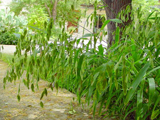Native Plants

Q. Who is Mr. Smarty Plants?
A: There are those who suspect Wildflower Center volunteers are the culpable and capable culprits. Yet, others think staff members play some, albeit small, role. You can torture us with your plant questions, but we will never reveal the Green Guru's secret identity.
Did you know you can access the Native Plant Information Network with your web-enabled smartphone?
Ask Mr. Smarty Plants is a free service provided by the staff and volunteers at the Lady Bird Johnson Wildflower Center.

rate this answer
Thursday - August 04, 2011
From: Houston, TX
Region: Southwest
Topic: Container Gardens, Grasses or Grass-like
Title: Native grasses for wood planter box in Houston
Answered by: Nan Hampton
QUESTION:
Hi, I'm making a long wood planter box/bench for my wood deck. The area gets direct sun only in the late afternoon/evening and the deck serves as a play space for our one-year old son. I'd like to plant some Texas native tall grasses, preferably of the very low maintenance/low water consumption variety, with the key being that they can't be dangerous in any way for our son. Also, since they'll be in a shallow planter, I'll have to find species that don't need a lot of soil to thrive. Do you have any suggestions? Thanks in advance!ANSWER:
Your idea sounds great, but there may be a couple of problems. First of all, how shallow is the planter box? Tall grasses are going to need more than 6 to 8 inches of soil to grow in—something that allows around a foot of soil would be best. Their fibrous roots can spread sideways but they also need enough soil to allow the root surfaces to be able to absorb moisture and nutrients. The second problem is that very few grasses grow well in the shade. There are a few that grow well in partial shade (2 to 6 hours of sun per day) and I will recommend a few of these that grow between 3 and 6 feet tall. The good news is that you don't need to worry about toxicity with native grasses and we can avoid any with sharp leaves. You should read one of our How to Aricles, Container Gardening with Native Plants, that will give you good general tips about creating a container garden.
All of the grasses listed are perennials. In the winter they will turn brown. Some of them are attractive with their golden or brown foliage and they resprout from the roots in the spring. You can cut the old brown foliage before or after the resprouting in the spring.
Chasmanthium latifolium (Inland sea oats) grows to 4 feet high and prefers shade. It may require slightly more water than the other grasses listed below, but will do fine is moderately dry soil.
Sorghastrum nutans (Indiangrass) can grow as tall as 8 feet.
Panicum virgatum (Switchgrass) grows to 6 feet.
Setaria scheelei (Southwestern bristlegrass) can grow to 4 feet tall.
Here are two other suggestions that aren't grasses but of the same general size. One of their advantages is that they are both evergreen. Neither is toxic.
Nolina texana (Texas sacahuista) is not a true grass but a member of the Lily Family. It grows to about 3 feet high.
Sabal minor (Dwarf palmetto) is a small palm that grows 3 to 6 feet high and is evergreen.
From the Image Gallery
More Container Gardens Questions
Hot Sunny Planter Suggestions for Florida
March 05, 2013 - We have a large, raised, concrete planter (about 15' L x 2' W) separating us from our condo neighbor in Clearwater, FL. We would like suggestions for shrubs that tolerate full sun and hot conditions...
view the full question and answer
Green blooms on Cedar Sage in Lucas TX
September 22, 2010 - I have two Cedar Sage (Salvia roemeriana) one purchased from your plant sale and one from a local nursery planted in part shade in the Dallas area.
They seem to be quite happy and are blooming but ...
view the full question and answer
Plant to cover retaining wall in Carlisle PA
August 01, 2010 - I have a block retaining wall in my back yard. I need to find a quick growing plant that will grow through late summer into fall and cover the wall with limited sunlight.
view the full question and answer
Failure to thrive of closet plant
August 13, 2008 - I have a closet plant that is old and was doing fine and then started having droopy leaves. It needed to be in a larger pot so I transplanted into a larger pot with new potting soil. It continues to...
view the full question and answer
Native plant for container on deck in Oak Grove VA
April 05, 2011 - What VA native plant can I grow in a container on my deck that will block the view from the neighbor's deck? I am thinking columnar. This is in full sun and gets hot winds off of a bay. The plant ...
view the full question and answer
| Support the Wildflower Center by Donating Online or Becoming a Member today. |

